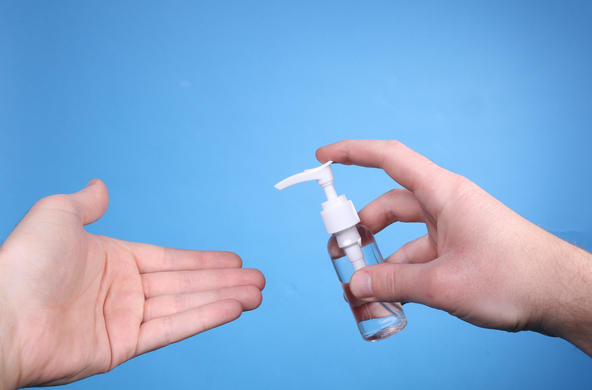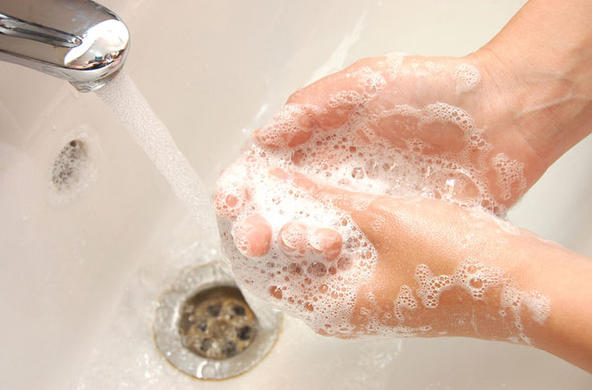Hand sanitizers have become all but ubiquitous in the West. In the United States it's a $200-million a year industry. While these cleansers can be useful, notably in clinical environments, they are far from being a benign frippery: they bear not only an environmental cost, but can bear a medical cost too.
A study published in Plos One in October showed that because hand sanitizers increase the permeability of the skin, using them and then handling thermal paper (the kind commonly put out by credit card terminals, cash registers, taxi drivers) causes the body to absorb bisphenol A, a hormone-disrupting chemical that's incredibly common. This is all the more pertinent if you sanitize, handle thermal paper and then eat with your hands.
The paper dwelled on the BPA, which has been found in 95% of American adults' urine. Hand sanitizers aren't that ubiquitous yet, but unthinking use of them is arguably one of the ills of the consumption-crazy west.
The purpose of sanitizers is to, well, sanitize your hands in the absence of soap and water. Some people, possibly forgetting what "soap" does, even use them after washing their hands.
Hand sanitizers contain an active ingredient, usually alcohol, that kills some if not all bacteria. The mania for sanitizing has become so prevalent that in Israel at least, some parents are shocked – shocked! when others don't carry it about with them to keep the kids squeaky "clean". Never mind that they may smoke in the living room or let the dog sleep in the bed: if the kid touches a jungle gym, he gets sprayed.
Some schools in Israel even require children to bring a bottle of the stuff together with their pen and exercise books, despite new research done in New Zealand showing that the practice does not in fact reduce absenteeism in schools (where kids could alternative wash their hands). For many – women at least, as most men still don’t carry around pocketbooks – these sanitizers have become almost a status symbol ostensibly indicating that the carrier is clean while non-carriers are slobs.
As there is no water laving away the dirt, at most, the alcohol in the sanitizers kills some bacteria, and possibly reduces viral and fungal flora while about it. Cleaner, you are not; more sterile than before, you probably are. But is that necessarily a good thing?
Sure, in a hospital. Or if somebody sneezes on your hands, fine, go ahead and sanitize. It's also good for people out in the field – soldiers come to mind – who don't have access to soap and water. But in the playground or classroom? The Hygiene Hypothesis, first published by Dr. David Strachen in 1989, postulates that one reason for rising incidence of allergies and illness among western children is the effort to sterilize their environment.
Unchallenged immune systems remain stunted, says the hypothesis. Some even believe the immune challenge can result in serious illness later in life, including diabetes and nervous system impairment.
The Hygiene Hypothesis remains controversial (a paper in the International Journal of Pediatric Otorhinolaryngology in 2013 by a team headed by Dr. Emmanuel Prokopakis of the University of Crete spells out the controversies). That said, a great many studies have found that children living on farms or even urban kids growing up with pets (hair! parasites! doo doo!) and in big families (ditto…) have been repeatedly shown to have less allergies than their pet-less peers.
Put simply, kids who grow up with dirt have more germs in their system, and seem better able to deal with them.
Prokopakis points out that there is no proven link between hand sanitizers and the Hygiene Hypothesis, let alone immune dysfunction, but confesses he finds the thought intriguing. "We may only assume, that the extensive use of hand sanitizers in western countries is associated with the increase of allergies (among other reasons), based on the hygiene hypothesis," he elaborates by email to Haaretz.
A twist on this theory was proposed in 2003, by the scientist Graham Rook, who broached the "old friends" theory. Man evolved with certain bacteria on his skin, in his mouth and in his guts and in fact. Far from being agents of disease, these "germs" are crucial to our health, helping us digest among other things, and fighting with non-benign bugs. In 1998 a group of scientists even published evidence associating childhood acute lymphoblastic leukemia – a growing problem in the west but not in the developing nations - with excessive hygiene conditions.
Cleansing and superbugs
That isn't to say that living in a sewer will make you healthy: but over-cleansing can evidently do harm. Washing your hands after using the toilet is good; habitually cleansing after shaking hands with a new acquaintance is overkill.
If anything, over-use of anti-bacterial agents is among the elements associated with the rise of so-called superbugs, that are resistant to the usual range of antibiotics.
As for what you wash with, the U.S. Food and Drugs Administration itself has said that hand sanitizers are no better than soap. In 2011 the FDA even stated that though the sanitizers can kill many germs and are better than not cleansing at all, manufacturers are wrong to claim that they "prevent infection from MRSA, E. coli, salmonella, flu, or other bacteria or viruses".
Shame about the liver damage
Another problem is that many hand sanitizers (and other household staples such as toothpaste) may contain the anti-bacterial hormone-disrupting pesticide triclosan, or its cousin triclocarbon. These are readily absorbed by the skin - and have been shown to impair thyroid function and damage our liver and muscles. Liquid soaps often have these chemicals too, by the way. Plain soap does not.
Other studies have demonstrated that triclosan depresses central nervous system functioning.
Triclosan is so common that a 2007 study found it in 97% of breast-milk samples (based on 62 women in Texas and California); and 75% of urine samples in the U.S. (2,517 people).
If you're going to use a hand sanitizer, choose one without these chemicals. They do exist. And while about it, for the sake of efficacy, choose one with alcohol content greater than 60%, advises the CDC.
Poisoning our water
The first aspect of the environmental aspect is fairly obvious. Using a product we don't need is a waste of precious resources. And a lot of resources are going into these products: In the U.S. alone, hand sanitizers are a $200 million a year industry – and sales are expected to double and more by the year 2015, to more than $400 million a year, according to the marketing research firm Global Industry Analysts of California. Sales have been heartily boosted by spikes in widely-reported diseases, like SARS or, more recently, Ebola.
Then after its use, we have millions upon millions of plastic bottles adding to the billions of tons of plastic waste polluting our planet. We have the spread of superbugs which is being abetted by unthinking use of these gels – that could be considered an environmental hazard as well.
There's also a fire hazard in the sense that alcohol is flammable, and sanitizers contain a lot of that - which is why some people drink the stuff, a habit that reportedly started in prisons. A sanitizer with 62 percent ethyl alcohol is equivalent to a 120-proof drink. However, tell your kids: they really could go blind. The alcohol in sanitizers is usually poisonous and can damage the liver and nervous system. Some manufacturers have started putting vile-tasting additives in the stuff on purpose.
And finally, for dessert, we have contamination of our water supply bodies by triclosan and triclocarbon, which are synthetic – they do not occur naturally. They get into the water because almost all the products containig triclosan and triclocarbon wind up getting washed down the drain.
Back in 2002, the U.S. Geological Survey detected triclosan in 58% of 85 rivers and streams tested in 30 states, and a September 2013 paper by the Cary Institute of Ecosystem Studies reports commonly finding the chemicals throughout the American water system. And what is this synthetic chemical doing there? Fueling the development of drug-resistant bacteria, says the paper. Now you know.






